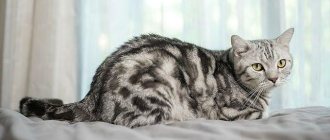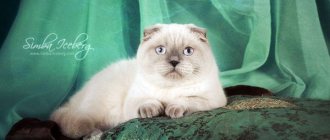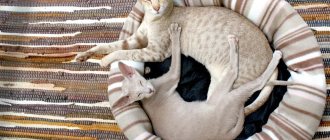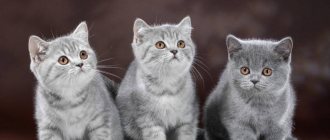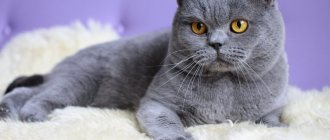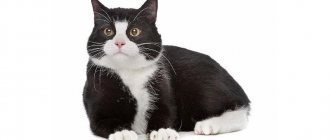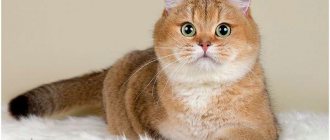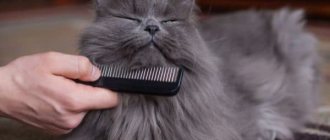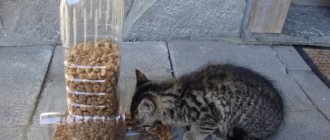A person may encounter such a concept as a ticked cat when choosing a pet. This rare and unusual color of the animal is becoming very popular among breeders and cat lovers. Just 10 years ago, only Abyssinian breeds could boast of such fur; today, ticking can be observed in other representatives, such as Peking Red, American, Persian, Norwegian Forest, Maine Coon, Scottish, British, Sphynx and other breeds of cats.
Solid (solid, plain)
A solid color implies the absence of any slightest admixture of other shades. The surface of the fur is colored evenly on all parts of the body. The Scots once upon a time considered gray or blue to be the most common color. These are the favorites most often found among breeders. But today seals with other colors are also gaining more and more popularity: white, chocolate, black, brown, cream, red and fawn (which literally means the color of a young deer). Sometimes it happens that nature interferes with the uniform color of the fur and leaves a mark of a different color there. Such cats noticeably lose value because they are considered a breed defect.
How would this be scientific?
The types of colors of Maine Coon cats in the unified international EMS system are assigned codes consisting of letters and numbers, each of which indicates a particular color characteristic:
- main color
| n | black |
| a | blue |
| d | red |
| e | cream |
| f | black turtle |
| g | blue cream turtle |
| s | silver or smoke (manifestation of one gene, but patterned individuals are called silver, and solid ones “smoky”) |
| w | white (may be due to the manifestation of different genes) |
- presence and type of white spots
| 01 | van (white individual with a small spot, spots of the main color) |
| 02 | harlequin (two thirds of the individual is white) |
| 03 | two-color or bicolor |
| 09 | with white (less than half white) |
- the presence of a pattern on the fur and its appearance
| 22 | marbled or classic tabby (“M” on the forehead and beautiful “butterflies” on the sides of the individual) |
| 23 | brindle tabby or mackerel (“M” on the forehead and stripes all over the body) |
| 24 | spotted (Maine Coons have torn tiger or merle) |
| 21 | agouti factor (recorded when it is clear that the animal is a tabby, but it is not clear what kind of pattern it is) |
| 11 | shaded (tabby on silver with a blurry pattern on the body) |
| 12 | chinchilla - black series of colors, cameo - red series (very strong silver, in which the animal looks almost white with a slight touch of the main tone, sometimes completely white) |
- eye color (not always indicated)
| 61 | blue - blue |
| 62 | yellow, golden - yellow, orange, golden, etc. |
| 63 | oddeyed - disagreement |
| 64 | green - green |
In terms of primary color, the following Maine Coon colors are allowed: black, white, red, blue, cream, cream-blue and tortoiseshell. Shades of chocolate and cinnamon are strictly prohibited for Maine Coons.
Main characteristics of color
A cat's coat can only be recognized as ticked if:
- there is no extraneous pattern at all on the animal’s body - neither clear nor blurry;
- On each hair on the animal’s fur there are several dark and light stripes (at least 3 dark stripes).
In the ticked color, among other things, stripes are allowed on the tip of the tail and paws, the presence of a “necklace” on the neck, as well as stripes in the shape of the letter “M” on the forehead. Such drawings are not considered a reason for disqualifying cats of any breed except Abyssinian.
What is ticking
Cats with fur of this color really look very attractive and unusual. The fur coat of such pets does not have the usual stripes and at the same time it does not look monochromatic.
Ticked color in cats is also called “color without color.” In this case, the stripes are not located directly on the animal’s body, but on each individual hair. A cat with such fur looks as if covered with freckles. When such an animal moves, its fur seems to shimmer and shine. Many people believe that this coloring is very similar to the colors of squirrels or chinchillas.
Painted cats
The coat pattern often found among Maines is called tabby or, if pronounced in English, tabby. Scientists claim that tabby is present in the genotype of all cats without exception - they inherited it from their wild forest ancestors. The pattern is obtained due to the fact that, under the influence of a certain gene, the color of cat hair is zoned. Simply put, this means that the hair is not monochrome, but striped, as can be seen upon closer inspection.
Varieties of tabby
As mentioned above, tabby is divided into several varieties:
- marble;
- striped;
- spotted;
- ticked.
Each variety has a number: 22 – marble, 23 – maskerel, 24 – spotted, 25 – ticked, respectively, added at the end of the main encoding.
spotted | spotted
maskerel | striped
marble | marble
ticked | ticked
The British tabby color has light colors, and the pattern on the coat is dark colors: black, red, blue.
Tabby colors are divided into:
- BRI 22 | 23 | 24 | 25 – color points;
- BRI 22 | 23 | 24 | 25 – bicolor;
- golden BRI y 22 | 23 | 24 | 25 - golden tabby;
- silver BRI s 22 | 23 | 24 | 25 – silver tabby;
- cream BRI e 22 | 23 | 24 | 25 – cream tabby;
- red BRI d 22 | 23 | 24 | 25 – red tabby;
- fawn BRI p 22 | 23 | 24 | 25 - tabby fawn;
- cinnamon BRI o 22 | 23 | 24 | 25 - cinnamon tabby;
- chocolate BRI b 22 | 23 | 24 | 25 - chocolate tabby;
- blue BRI a 22 | 23 | 24 | 25 - blue tabby;
- brown BRI n 22 | 23 | 24 | 25 ‒ black | brown tabby;
- lilac BRI from 22 | 23 | 24 | 25 - lilac tabby.
British color point 24 and Scottish fold kitten
BRI ay 25 blue golden ticked
SFS 71 n 03 22 – Scottish Straight Black Marbled Bicolor
BRI bs 22 62 – chocolate marble on silver
Marble
Marble color is considered the most interesting and effective, among other variations. The Marbled Briton has two wide stripes on the back, from which radiate ring-shaped patterns filled in on the inside. The color, just like the others, must meet basic standards. It stands out from the rest in that the pattern on the wool represents a complete, complete picture without “breaks.” The pattern on the shoulder blades often resembles a butterfly, and striking stripes run from the corners of the eyes along the cheeks. The rings on the cat's neck must be closed, another irreplaceable feature of the merle color, and the quantity and price of the pet are directly related. If the pattern on the coat is not contrasting, then the color is considered defective. A marble pattern is visible on the kitten from the first days of life, and by two months it becomes bright and clearly visible.
The character of a British pet with a merle pattern is absolutely no different from the character of its counterparts with a different pattern; future owners are interested in this, since it seems that an animal of this color belongs to a different breed.
BRI d 22 - British Shorthair Red Marble
BRI f 22 – black tortoiseshell marble
Striped | brindle | whiskey
Striped | Markel coloring of British cats is quite rare, but is more common than marble. There are cases in which the striped pattern of the cub begins to be interrupted during growth, then the pattern begins to be classified as leopard.
The basic elements remain the same: circular stripes on the paws and neck, the letter "M" on the forehead, eyeliner in the same color. A tiger cat is distinguished, as one could understand from the subtitle, by contrasting stripes that run in a solid line from the back to the paws and should be quite narrow and often repeated, and the more often, the more the pet is valued. The full color is formed approximately 12 months after the kitten is born, which is rare among other color varieties. British tabby cats have golden or green eyes.
BRI ny 23
The basic elements remain the same: circular stripes on the paws and neck, the letter "M" on the forehead, eyeliner in the same color. A tiger cat is distinguished, as one could understand from the subtitle, by contrasting stripes that run in a solid line from the back to the paws and should be quite narrow and often repeated, and the more often, the more the pet is valued. The full color is formed approximately 12 months after the kitten is born, which is rare among other color varieties. British tabby cats have golden or green eyes.
Spotted | leopard print
Spotted colors | spotted tabby British cats are the most common and popular among cat lovers. Such offspring can arise from any tabby parents. A cat in this color resembles a leopard, which is the reason for the alternative name, and has all the characteristic features of a tabby: contrasting circles, stripes and rings, light spots on the ears. The spots of this color may not be the same as what people are used to, but represent dashed and dash-dotted lines. Without this, the spotted tabby color is impossible. Animals with spotted patterns may have sandy or green eyes.
BRI n 24 - British Longhair, black spotted
BRI q 24 – tortoiseshell spotted cinnamon
BRITISH STRIPED COLOR (BRINCH, MACKERL)
The striped color of the British (British brindle tabby) must comply with all the same standards as the spotted one, only the pattern on the back and sides must have clear and uninterrupted stripes. In the color of a British Tabby Shorthair cat, the stripes should start at the spine and extend all the way to the paws. The stripes of a British brindle cat are narrow and frequent (and it is believed that the more often the better). Mackerel stripes (mackerel) should not intersect each other, be strictly vertical and always contrasting.
A brindle (striped) British kitten, even with very clear stripes, can “stretch” its color by adulthood and, if the stripes begin to be interrupted anywhere, the color is reviewed by experts and assigned - spotted. The full color of a British brindle kitten will be formed only by the age of one year (other tabby colors are not subject to such changes and most often do not change the appearance of the tabby pattern in adulthood).
Read also: Frederic Chopin (February 22, 1810
British tabby cats are not as common as spotted cats, but more common than marbled cats.
The eye color of British tabby cats can be copper (golden, orange) or green (gold, occasionally silver).
Chocolate tabby British kitten: photo of California
Abyssinian cat breed
The Abyssinian cat breed originated in Ethiopia (formerly called Abyssinia). The ancestor of modern Abyssinians was a rabbit-colored cat named Zula, brought by his English owner from Abyssinia to Great Britain in 1868. Abyssinian cats are medium-sized short-haired cats with a slender build and well-developed muscles. Abyssinians have a small head with relatively large, widely spaced ears. Almond-shaped eyes (usually yellow or green) are outlined with a dark outline. The nose is straight, of medium length, no stop. Abyssinians have a short but graceful neck, a well-developed back and chest, and a fairly large tail. The legs are long or medium-sized, but at the same time, the paws themselves are quite small, which gives the impression that the cat is standing “on tiptoes.”
Black ticked color
The coding for this color is as follows: n 25. Cats with this color have a black pattern on a copper background. The nose and eyes of animals are surrounded by a rim. The color of this edging is dark. Cats have a brick red nose and eyes that can be any color, including green. Pets with such fur do not have only blue eyes. The paw pads of black ticked animals are brown or black as standard.
Red ticked
The coat of d 25 cats not only looks unusual due to the ticking, but is also very bright. The pattern on the body of such animals is deep red on a red background. The nose and mouth of ticked cats of this color are also surrounded by a rim of the same color.
The eyes of animals in this group can range in color from yellow to brown. The nose and paw pads are brick red.
Tipping and ticking. What it is
Administrator
Before talking about tipping and ticking, let us remember that a cat has a phenotype (appearance) and a genotype (a set of microscopic objects invisible to the naked eye - carriers of hereditary information that determine external characteristics, including color elements). The terms “tipping” and “shading” relate only to the phenotype and describe elements of appearance. But the term “ticking” refers to both the phenotypic element and the gene responsible for the so-called ticked color. Therefore, it is with ticking that it is easiest to get confused.
Zonal staining: what does it mean?
In kittens of ticked color, each hair of the fur is shaded with light and dark stripes of different colors - thanks to this, the fur visually seems to shimmer. Such a natural coat pattern in cats is very rare, so the science of genetics has come to the aid of breeders in this matter. To breed an animal with zonal hair coloring, a mating between representatives of such breeds as Scottish Fold cats and a British cat was needed. Since 2010, there is no need for complex crossbreeding, since breeders have enough males and females with ticked colors in different variations. Felinologists highlight the fact that in classical ticking, two genes predominate - the Abyssinian gene (Tabby) and the “general” ticking (Unpatterned). The pet's color most often combines black and gold, but it can be:
Fluffies with such fur can have marbled colors.
- brindle;
- marble;
- zonal;
- patchwork;
- spotted.
In kittens of the Scottish breed of ticked color, the pattern shades as the baby grows - this is considered the norm.
Secrets of genetics
Breeders consider breeding ticked cats to be a difficult task, but at the same time very exciting. At the moment, experts have been able to identify only two genes responsible for this design of the fur of furry pets: Abyssinian and common ticking.
The first gene gives the animal's hairs ticking with the same frequency of stripes. In this case, coloring with triple zoning is considered ideal. Mandatory for such an exterior is, among other things, a stripe on the back of a slightly darker shade than the body color.
The general ticking gene does not give the number of stripes on the hairs and their distribution, but simply smoothes out the saturation in the cat’s color. The homozygous form of this U gene is capable of making the pattern on the animal’s body almost invisible. In a heterozygous one, a clear pattern is observed on the paws and tail, as well as a shadow pattern on the body. This gene has the peculiarity that it begins its work from the very birth of the kitten.
Genetics of tabby color
Thanks for the patterned colors should be the agouti gene (A), responsible for the presence of the pattern, and the tabby gene (T), responsible for the nature of the pattern.
There are four genes in total:
- Ta – ticked;
- T – striped or spotted;
- tb – marble.
Dominance:
- Ta dominates over T and tb colors;
- T is dominant over tb color;
- tb – recessive color.
Formula:
- AA - tabby, such an animal will always produce offspring with patterns;
- Aa - tabby, this animal can produce kittens with or without a pattern;
- aa is an animal without patterns, the offspring from it, accordingly, will also be monochromatic.
Spotted tabby (leopard)
With the help of the tabby gene and a set of polygenes, which seem to break the patterns on the cat’s body, a spotted color is formed. The spots contrast with the main color of the animal and are clearly defined, do not merge or intersect. The striped color becomes mottled even with little exposure to polygenes. This explains why spotted cats are much more common. The merle color is not so afraid of the effects of polygenes, because it will be considered spotted only if it is completely divided into clear spots of small sizes. By the pattern on the coat, it is most often noticeable from what color the spots were formed.
BSH n 24
Classic, blotched
It is a form of the tabby gene (tb). It is distinguished by its extraordinary beauty and rarity. The drawing is rich and contrasting. The butterfly-like pattern on the shoulder blades is one of the main distinguishing features. There are wide stripes along the ridge of the animal, and expressive large spots adorn the sides. It has a modification of marble, characterized in that it has a less pronounced middle and pronounced edges.
Red marble BRI d 22
brown tabby BRI n 22
Black marble silver ns 22
silver tabby BRI ns 22 64
Tiger, maskerel tabby (tiger)
This type of pattern is rare among tabby cats, but not as rare as merle. From head to tail there is a straight wide line, from which frequent, unbroken narrow stripes extend. The stripes tend to tear and then the tiger color turns into leopard, which is the reason for the rarity of the striped variety. Formed using the T gene.
Ticked tabby
The Ta genome is formed, which is dominant among all others. With this color there are practically no patterns, and the entire body is covered with ticked (striped) hairs. Despite the dominance of the gene, it is quite rare, being a gift from the Abyssinian breed, which does not currently exist. The value of this color is the intensity of the main tone of the animal’s coat and the undercoat of pleasant delicate shades.
BLH ns 25
ds 25 red silver ticked
Disadvantages of tabby color: “torn”, unclear and asymmetrical pattern, absence or non-closed rings on the neck. For light-colored animals, a brown or grayish undercoat color is unacceptable.
Eyes: Shades of orange or emerald eye color are acceptable, based on the basic tone of the British cat.
"Silver" and "gold" tabby
If you pay enough attention to the background, and not just the pattern, then the patterns on the wool take on a beautiful appearance. With the help of additional polygenes, you can give the undercoat a copper tone. Add a golden and unusual hue. And if you influence the pattern with the Silver gene, the tone will change to a pronounced pearl color and become silver.
Cons: There are many requirements for the golden and silver shade of the undercoat. So “gold” should have a color without any admixtures of brown and gray, and “silver” should have no yellow tint. The yellow discoloration that most often appears on the nose, paws and chest is called ruffism. It has been observed that breeds in which the fine “gold” silver contains rufisms, and in the pedigree with good “silver” the “gold” has an inappropriate undercoat color.
Eyes: “gold” must have green shades of eyes, “silver”, in addition to green, may have orange.
Moire or drawing?
When the Aguti gene does not have the proper effect on color, the cat's color becomes flat and without a pattern. The pattern on such cats is visible as moiré, despite the fact that at birth it was quite contrasting. A similar effect is observed in lion cubs and cubs of other feline species. There is a pattern in the genotype of any cat, but in order for it to appear, the influence of the Aguti gene is necessary.
Disadvantages: the disadvantages of cats without a pattern are the features of their patterned counterparts - incomplete moire, uneven coloring of the coat along the entire length. In adult cats, moire should be absent.
Eye color: copper, others are not acceptable.
There are polygenes that eliminate moire, because of this the moire pattern becomes either completely invisible or too bright, which misleads breeders. The cat appears to be tabby in color, which is not the case.
Distinguishing a pattern from a moire pattern is not as difficult as it seems. In tabby, the patterns are bright and contrasting, while in moire, they differ from the main type of coat by only a few tones.
SFL n 22 03
BRI h 22 – chocolate tortoise marble
How is fur color formed in kittens?
In a kitten, not only the structure of the hair and the composition of the coat changes rapidly, but also the color itself. In many cat breeds, it is impossible to judge the quality of color until a certain age, until the fur has fully grown and colors have appeared. A kitten changes color up to 10 months, and before six months of age, only a professional breeder or expert felinologist can draw conclusions about its quality. Thus, kittens of some breeds develop protective covering hairs that make them look like porcupines - this happens at about a month of age, when the kittens begin to crawl out of the nest. This hair falls out no earlier than three months of age. In kittens that are carriers of the gene that determines the white color of the coat, in infancy a colored spot (the so-called baby cap) may appear on the top of the head. Point colors also do not appear immediately: kittens are born white. Rex kittens (a breed with curly fur) are born with straight hair.
The rarest colors of Scottish cats
Several years ago, the highest price was set for kittens of unusual silver and gold shades. But in the modern cat market there are more and more of them. Today, ticked Scots and golden chinchillas are considered the most expensive.
Scottish straight golden chinchilla
Interesting! The most common iris color among Scots is gold. However, there are some exceptions. Usually the eye color matches the coat. Blue or multi-colored eyes are quite rare, these animals can be white, bicolor or tortie. Orange iris is a very beautiful, but the rarest eye color in this breed.
Character
British chinchilla cats are distinguished by aristocratic manners, calmness, and a good nervous system. Up to a year old, babies are very active and love to play. Adult pets are most often balanced and treat their owner as a friend. The British do not like to sit on their hands; they prefer to approach them themselves for a portion of affection.
Animals understand the situation very well and are able to manipulate the owner and family members. Plush beauties most often cannot stand strangers; there are known cases of hostility towards drunken visitors to the house. But by purchasing a British chinchilla cat, a person receives a devoted companion. The pet is attached to the house and can resort to tricks if the owner is forced to say goodbye to it. Sometimes they hide or pretend to be sick when strangers appear.
British Chinchillas get along well with other pets indoors. But the arrival of a new pet must be planned. It is necessary to separate the arriving baby from the old friend. Gradually allow animals to be together. If you do not provide for the behavior of pets, you can get sick and sick in cats.
British chinchillas are prone to depression. They buy toys and mazes for the animal. A mobile, active pet eats well and looks great.
The description of the breed and character of the British chinchilla shows: pets get along well with children. But you should not allow your child to squeeze and knead the baby immediately after coming into the house. The furry baby is given time to get used to the new home, food, smells and sounds.
Features of care
Despite its “royal coat,” the animal is not adapted to low temperatures. A comfortable temperature for him is above 20 degrees Celsius.
Hygiene
Caring for a golden Scottish chinchilla involves several procedures, but the main thing is coat care:
- once a week comb out with a special brush in two directions;
- after combing, collect hairs with a damp hand;
- during the molting period, comb out daily.
Cats do not like bathing, but once every six months they need to do water treatments with a special shampoo.
Process as needed:
- ears - clean out accumulated dirt with a swab moistened with petroleum jelly;
- eyes - wipe with tea leaves, chamomile infusion;
- nose - remove discharge with a napkin;
- teeth - brushed daily with a special soft-bristle brush or a cat brush placed on your finger;
- claws - as they grow, remove them with a nail clipper.
Periodically take the chinchilla for a walk, before putting on a flea collar.
The cat is exceptionally clean and loves hygiene, so the litter box must be kept clean.
Nutrition
Golden Scottish chinchillas have a good appetite and gain weight easily, so the cat’s diet needs to be adjusted.
It is better to feed the animal with premium balanced dry food. It contains the entire complex of vitamins and microelements necessary for the body.
When feeding with natural products, the diet includes:
- boiled chicken, turkey, veal, rabbit, offal;
- boiled sea fish fillet;
- fermented milk products, eggs;
- vegetables, boiled cereals;
- sprouted grains;
- complex of vitamins.
Regardless of what diet you choose, make sure that the kitten drinks a lot of clean water.
Color point
The Color Point is a rare breed of Scottish cat with a color similar to that of a Siamese cat. In childhood they look a little like Thai kittens. The main background is white or cream. The muzzle, ears, paws and tail are painted in darker shades. Color point or links point have blue eyes.
They acquired their colors from their British ancestors, who had Persians with this shade in their family. By the way, it is very difficult to distinguish a British cat from a Scottish one, and even professionals cannot always do this.
Ticked cat: color characteristics
This cat's fur looks like the fur coat of a wild rabbit or chinchilla; on it you can see specks similar to freckles or small ripples on the body. The pet does not have the usual spots or stripes, but you can find a pattern (stripes) on its face, paws or tail. These are mainly the individual characteristics of Scottish breeds. As the animal moves, the fur shimmers and shines. This effect is achieved thanks to the natural original color of the fiber. Each hair is combined by alternating 2-3 colors on a light background. There are 8 types of ticking - lilac, cream, chocolate, black, cinnamon, fawn, blue, red. Thanks to the Abyssinian gene (Tabby), which erases the pattern as the pet grows, it is possible to achieve the most unexpected variations of ticked coat color in a cat.
Ticking and tabby – patterned colors
Tabby pattern samples
The secret is simple - the presence of ticking. Ticking is the zonal coloring of each hair with stripes of light and dark pigmentation. The hair is densely colored at the tip, then there is a light stripe, then again a densely pigmented area, going down to the light root of the hair. Ticking is a result of the expression of the agouti gene, which is why the light stripes are often called “agouti stripes.” In black group colors, agouti stripes are usually yellowish-brown and correspond to a period of slowing eumelanin production. If the agouti gene is not expressed, then agouti striping is absent, and we have the opportunity to observe a solid color.
However, the agouti color in its pure form, consisting only of hairs with alternating contrasting dark and light stripes and not having even a hint of any pattern in any part of the body, is not found in cats. This is explained by the fact that all cats, without exception, are genetically patterned - tabby. The tabby gene is responsible for the appearance of stripes and spots of the main color on the ticked coat. There will be no ticked wool - the pattern will not be visible. A solid black cat is also, by and large, a patterned tabby cat, but we cannot see the black tabby pattern on a black background. And since the agouti gene is responsible for the presence or absence of ticking, it depends on it whether the tabby pattern existing in the genotype will appear or not. The following tabby genes are known: ticked tabby (Abyssinian), brindle tabby (mackerel), classic tabby (marbled) and spotted tabby.
All tabby cats have characteristic markings on the face, limbs and tail: a dark edging of the brick-red nose and eyelids, a light spot on the back surface of the ear, creating a diamond-shaped pattern on the cheeks, stripes from the outer corner of the eye, a pattern in the shape of the letter “M” "on the forehead, a necklace on the chest, ring stripes on the limbs and tail. The rest of the pattern is determined by what type of tabby gene is manifested in a given animal. The ticked example of the tabby pattern is the most free from the markings inherent in all tabbies: stripes remain on the limbs, and a slightly modified residual pattern remains on the muzzle.
TICKED SILVER BRITISH CATS: COLOR STANDARD
The main color tone of a ticked British silver cat most intensely colors the head, ears, back and tail of the animal, slightly less than the sides. The paws, chest, and belly are silver with a slight tint of the main coat color. The collar is silver without any admixture of another color tone.
The ticked color is very similar in appearance to the shaded color, only it colors the animal’s fur more intensely and brightly.
The undercoat should be as close to white as possible (the whiter the better).
The tabby pattern is completely absent, only the non-contrasting letter “M” on the forehead of British cats and the pattern on the head in the form of “glasses” are retained - also not too bright and clear. There will also be a small, lightened spot on the outside of each ear that resembles a fingerprint. The whole body is covered with ticking - i.e. Each hair is dyed with several stripes. If you look at such a silver ticked Briton as a whole, it should give the impression that the back and sides are simply one darkened color. No spots/stripes should disturb the ticking - this is a defect (either a very bad ticked color, or not a clear spotted one, which in any bad case).
Let's take a closer look at each type of color.
CLASSIC TICKED SILVER TYPES OF COLOR OF BRITISH CATS
British color black silver ticked BRI ns 25
The color of the British Silver Black Ticked Cat is bright silver, with the upper part covered in a black tone. The cat's eyes are green (the richer the better), the nose is red-burgundy with a black edging, and the paw pads are black.
British color blue silver ticked BRI as 25
The British silver blue ticked cat is covered with a light blue, the most intense color is on the back of the animal. The eyes are green and lined with blue, the nose is pink with a blue rim, the paw pads are blue.
British color lilac silver ticked BRI cs 25
A lilac tone is painted on parts of each hair (in the form of stripes), the main tone is bright silver. The eyes are green with pink edging, the nose mirror is pink, the foot pads are pink.
British color chocolate silver ticked BRI bs 25
A soft chocolate tone covers the silver color. The eyes of British cats are green with a brownish rim, the nose is dark pink with a brown rim, and the paw pads are chestnut.
British color cinnamon silver ticked BRI os 25
Delicate cinnamon tone combined with silver, where cinnamon creates stripes on every hair of the animal. Eyes are green. The nose is dark pink with a cinnamon border, and the llama pads are cinnamon color.
British color fawn silver ticked BRI ps 25
A very soft, beautiful fawn color covers silver on top. The ticked British silver cat's eyes are green with pink-sand edging, his nose is fawn color or pink with a fawn rim, his paw pads are beige.
SILVER TICKED CAMEO COLOR BRITISH
British color red silver ticked cameo BRI ds 25
The ticked red cameo color of British cats suggests the presence of red stripes on the coat, colored on every hair. The following parts of the body should be painted: the back, sides, outer parts of the paws and tail, head, ears, with the back and head of the animal being the most intensely colored. The belly and the entire inner part of the color remain white - matching the undercoat. Eyes – orange or copper. The pads of the paws and the nose are deep pink.
British color cream silver ticked cameo BRI es 25
A British cat of silver ticked cream cameo color looks almost white, but upon closer inspection you can see that a light cream covers every hair in the fur on the back, head, ears, sides, outside of the paws and tail, the rest of the color will remain white. The paw pads and nose are pink. Eyes – copper or orange (the brighter the better).
British silver ticked tortoiseshell cats
British silver ticked tortoiseshell cats can be of the following colors:
- black and red ticked tortoise BRI fs 25;
- chocolate red ticked tortoiseshell BRI hs 25;
- blue-cream ticked tortoiseshell BRI gs 25;
- lilac and cream ticked tortoiseshell BRI js 25;
- cinnamon-red ticked tortoiseshell BRI qs 25;
- fawn cream ticked tortoiseshell BRI rs 25.
The silver ticked tortoiseshell color of British cats is rare, but the requirements for both types of colors must be met. The two tones of tortoiseshell should be evenly distributed throughout the animal's body, and the ticked coat should have a white undercoat. The eye color of ticked British tortoiseshells can be green or golden. The nose and paw pads are the same color as the main color.
British silver ticked color point cats
British silver ticked color-point cats can be of the following colors:
- blue silver ticked point BRI as 25 33;
- black silver ticked point BRI ns 25 33;
- lilac silver ticked point BRI cs 25;
- chocolate silver ticked point BRI bs 25;
- cinnamon silver ticked point BRI os 25;
- fawn silver ticked BRI point ps 25;
- red silver ticked BRI point ds 25;
- cream silver ticked BRI point es 25.
Blue and black hair coloring on the silver ticked Briton is rare, but the other colors are considered so rare that even the breed experts themselves talk about them as a myth.
Mixed silver ticked colors of British cats
Mixed colors, such as silver tortoiseshell bicolors, silver tortoiseshell color-points, silver bicolor color-points, are found in kittens whose parents belonged to different color groups. Such colors do exist; the parameters and standards of the colors of each group must be strictly observed to an equal extent. However, it should be noted that experts do not really like mixed colors, since it is difficult to 100% track the result and overall appearance, so you need to be careful about such matings among the British.
TICKED BRITISH SILVER KITTENS
Ticked British Silver kittens can be born from parents of this color or from carriers of this color. At birth, ticked is similar to white, and it is very difficult to determine the degree of coloring and accurately say about the color. In any case, this gene must be present in the pedigree. At birth, kittens usually have quite a lot of residual pattern, which “blurs out” with age and turns into an even ticked color.
Ticked British silver kittens always look very expensive and elegant, and also, undoubtedly, evoke pride and admiration of others.
Tags
kittens of ticked color with ticked color for cats of cat breeds. cats have color of cats. bred cats with color of cats color of cats in addition to disqualifying cats of any color of cats in cats at Breeds about breeds Abyssinian breeds other breeds of cats. Scottish breed ticked Scottish breeds. famous breed 9 breeds comparison of breeds of two breeds and Abyssinian cat Heavy Siamese cat from Ticked catsCats look like hair. A cat's fur may be that of a cat's.
fawnlilachavecinnamonrepresentativescarecontentspinkreadyellowbri
Scottish cat color charts
When purchasing a Scottish kitten with a passport from a breeder, most likely you will see markings of numbers and letters there. This is an international code used in the classification accepted among breeders. The Scottish breed includes four cats: fold-eared (Scottish Fold), straight-eared (Scottish Straight), long-haired fold-eared (Highland Fold), straight-eared long-haired (Highland Straight).
This is what the color code looks like: XXX.xx.NN.NN.NN.(NN) , where:
XXX . Abbreviated name of the breed in three capital letters: SFS - Scottish Fold, SFS 71* - Scottish Straight, SFL - Highland Fold, SFL 71* - Highland Straight.
xx . Lowercase letters indicating the main coat color (up to two):
Russian nameabluebluebchocolate, brown, chestnutchocolate, brown, Havana, champagneclilac, lavenderlilac, lavender, platinumdred, flameredecreamcreamfluortoiseshell, patch tortoiseshellgblue-cream, blue-tortieblue cream, blue tortoisehchocolate-tortiechocolate tortoisejlilac-tortielilac turtle ovynblack, ebony, seal, sable, ruddyblack, ebony, seals, sable, wildosorrel, cinnamon, honeysorrel, cinnamon, honeypbeige fawnyellow-brown, beigeqsorrel tortiered-brown tortoiseshellrbeige fawn tortiebeige tortoiseshellsilver, smokesilver, smokywwhitewhiteygoldengoldenzunregisteredunregisteredNN.NN.NN.(NN) - values of pairs of digits (up to 3 main and 1 auxiliary):
- Numbers from 1 to 35, which decipher the color features (harlequin, van, smoke, etc.):
| Letter (designation) | English name | Russian name |
| 01 | van | van |
| 02 | harlequin | harlequin |
| 03 | bicolour | two-color, bicolor |
| 04 | mitted/white point | with white markings (for color points) |
| 09 | little white spots | white spotting (1-2 cm) |
| 11 | shaded | shaded (1/4 of the top part of the hair is darkened) |
| 12 | tipped, shell | veiled (1/8 of the top part of the hair is darkened) |
| 21 | tabby, agouti | striping, agouti factor |
| 22 | blotched, marble | marble |
| 23 | mackerel, tiger | mackerel, tiger |
| 24 | spotted | spotted |
| 25 | ticked | ticked or Abyssinian |
| 31 | burmese | Burmese |
| 32 | tonkinese | Tonkinese |
| 33 | himalayan or siam | Himalayan, Siamese, point |
| 34 | Singapore | Singaporean |
| 35 | abyssinian | Abyssinian |
- A pair of numbers from 51 to 54 indicating the length of the tail:
| Letter (designation) | English name | Russian name |
| 51 | rumpy | taillessness |
| 52 | rumpy riser | remainder of the tail – 1-2 vertebrae |
| 53 | stumpy | bob – 7-13 cm. curled tail |
| 54 | longy | long/normal tail |
- A pair of numbers from 61 to 67 indicating eye color:
| Letter (designation) | English name | Russian name |
| 61 | blue | blue |
| 62 | yellow, golden | yellow, orange, golden |
| 63 | oddeyed | disagreement |
| 64 | green | green |
| 65 | burmese | Burmese cat eye color |
| 66 | onkinese | Tonkinese cat eye color |
| 67 | himalayan or siam | eye color of Himalayan and Siamese cats |
- A pair of numbers 71 (straight) or 73 (dropping), indicating the shape of the ears.

